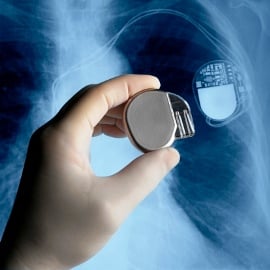
With the rapid emergence of electronic devices being used for communication, transportation, health care, commerce, construction, safety and more, battery performance has become an everyday concern. To keep pace, the battery market must continually seek longer life, faster recharge times, greater reliability, unfailing safety and lowered costs. As the developing power conversion industry faces these challenges, it has brought to the forefront new materials to push the boundaries of the energy storage industry.
There are two separate, yet specific areas of ongoing battery research and development: the commercialization of rechargeable conversion batteries and the use of solid state electrolytes.
Rechargeable Conversion Batteries
Developers of secondary batteries are seeking new cell chemistries to increase the amount of energy that can be stored and extend a device’s operational lifetime. One approach being developed utilizes fluoride cathode materials such as Aluminum Fluoride (AlF3), Bismuth Fluoride (BiF3), Copper Fluoride (CuF2), Ferrous Fluorides (FeF2, FeF3), and Nickel Fluoride (NiF2). These materials offer multiple electron chemistry, as opposed to the single electron chemistry, found in many current generation transition metal-based cathodes. While this great potential is understood in theory, developers are confronted with multiple challenges when considering these fluorides in pursuit of their battery development breakthroughs. Among them are the reversibility of the electrochemical reaction, high cell polarization and electrical conductivity issues.
Solid State Electrolytes
The benefits of solid state electrolytes can be found in their potential to enable a battery producer to switch from graphite or silicon-based anodes to lithium, thus allowing for much greater energy density. Lithium anodes are not currently safe for commercial application in cells using traditional liquid organic electrolytes. The reason is lithium dendrites readily form during cycling which can lead to cell failure with hazardous consequences. But a solid state electrolyte can, in principal, block dendrite formation with lithium anodes with the added benefit that they are free of flammable solvents. Solid state electrolytes are materials uniquely engineered to have good conductivity of lithium ions, while also maintaining stringent separation of the cathode and anode layers of a cell under demanding conditions. Examples of solid state electrolyte materials would include LIPON (made from Li3PO4), amorphous inorganic sulfides, and complex oxides of Aluminum Oxide (Al2O3-γ), Lanthanum Carbonate (La2(CO3)3), Lanthanum Oxide (La2O3), Lithium Carbonate (Li2CO3), Lithium Lanthanum Zirconium Oxide(LLZO) with and without dopants, and Zirconium Dioxide (ZrO2).
With a set of material chemistries designed for battery applications, Materion is enabling researchers to develop next generation conversion batteries and to pursue new solid state electrolytes, including oxide and sulphide chemistries. Using manufacturing capabilities that include solid state and reactive gas synthesis, particle size processing and comprehensive materials characterization, Materion is helping the industry push the boundaries of energy storage.